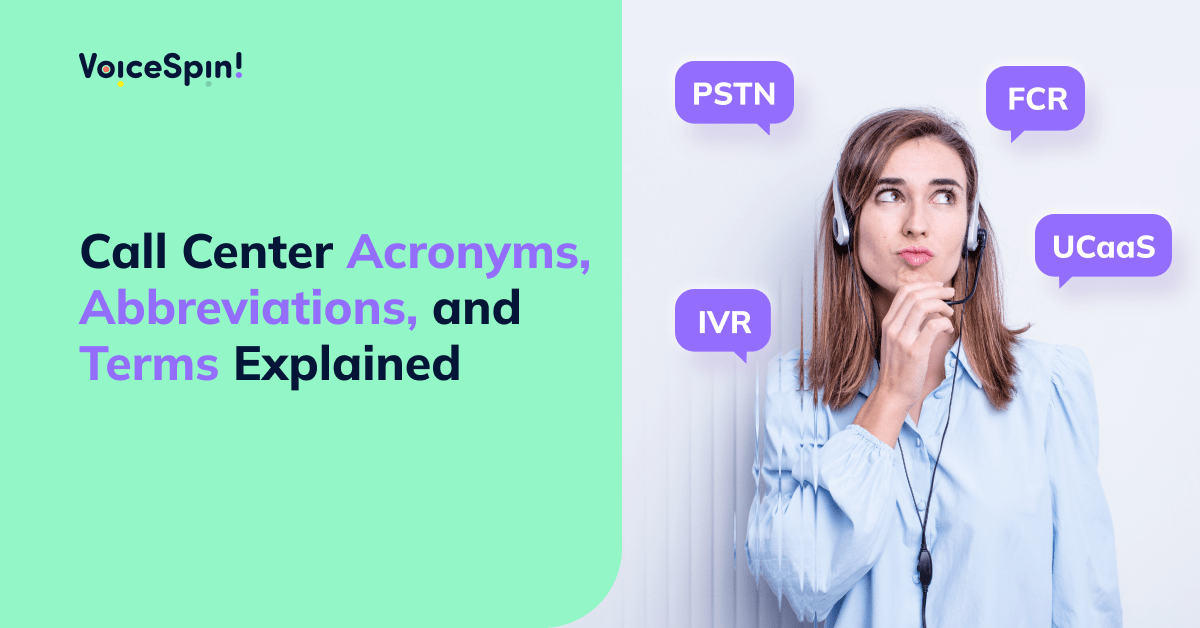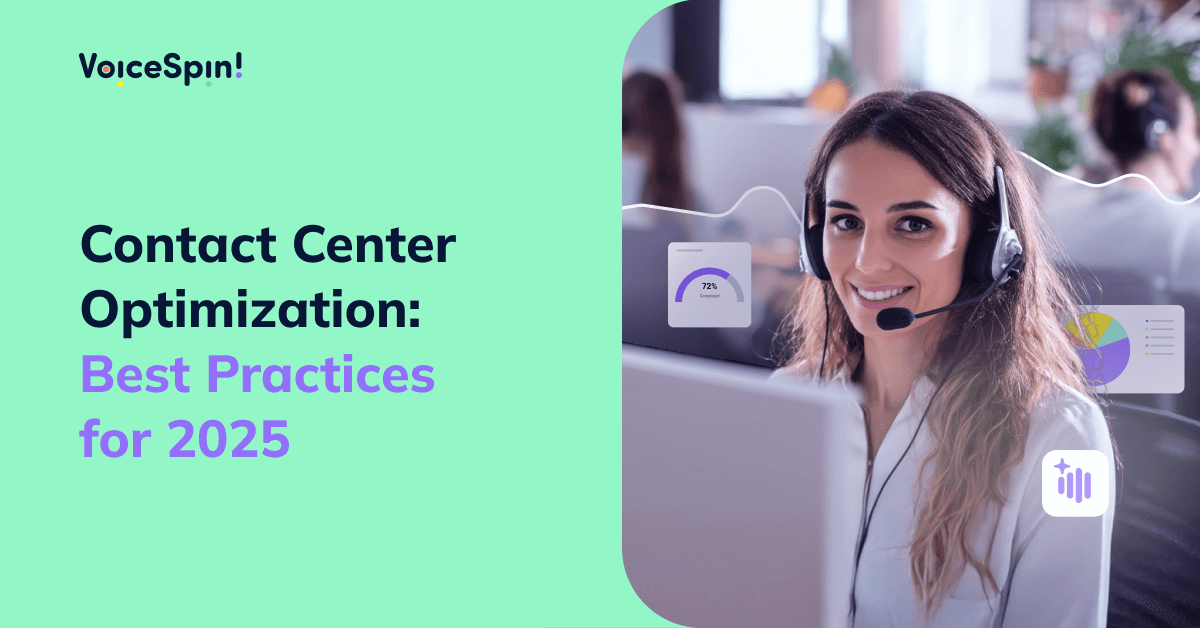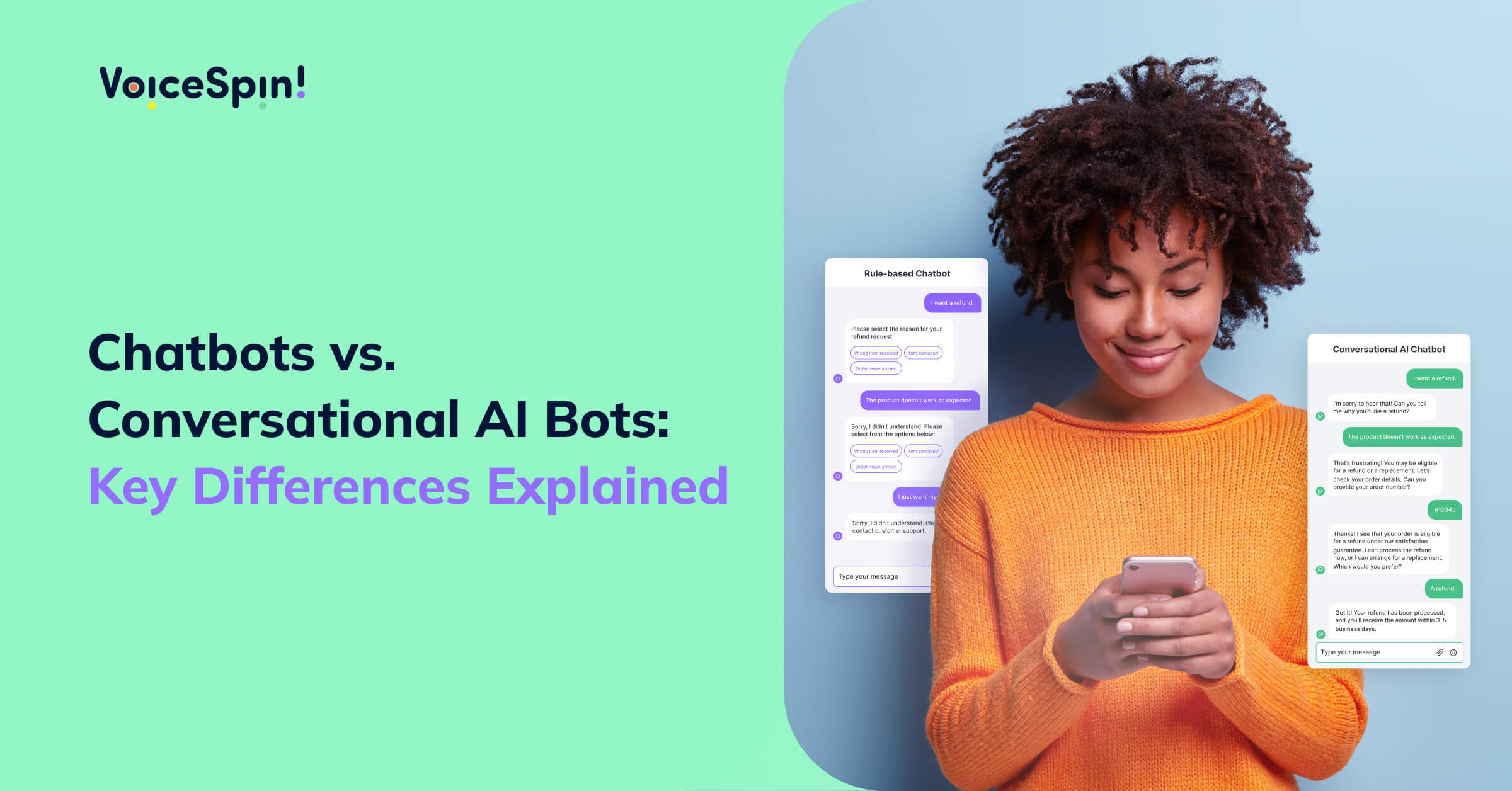The call center industry is full of specific terms hidden behind numerous acronyms and abbreviations. While some of them might be rather obvious, others might be tricky. Whether you are just starting out your career in the contact center space and still learning the ropes or are already working in customer service and support – at some point, you might come across an acronym you’re not yet familiar with.
Below, we’ve collected and briefly explained the meaning of the most popular and commonly used call center acronyms, abbreviations, and terms. From inbound and outbound call center software features to call center metrics and other related terms – you can use it as your go-to source whenever needed.
A – Call center terms and acronyms starting with A
Abandonment Rate
Abandonment Rate, or Call Abandonment Rate, refers to the percentage of inbound calls that are terminated by callers after being placed in a queue before their call is answered by an agent. It is an important metric that helps measure call center performance alongside other metrics.
After Call Work (ACW)
After Call Work, also known as Wrap-up Time or Post-call Work, is a call center metric that refers to the post-call activities call center agents perform after they complete their interaction with a customer before taking the next call. These may include updating customer profiles and logging call details in the CRM system, leaving call notes, scheduling follow-up actions, etc.
Agent Idle Time
Agent Idle Time is the time a call center agent isn’t handling calls or performing post-call-related tasks. Excessive agent idle time in inbound call centers may indicate that there are too many agents to handle the current call volume.
Agent Utilization
Agent utilization is a workforce management metric that measures the percentage of time a call center agent spends handling calls and performing post-call-related activities out of their total available time. Along with other metrics and KPIs, agent utilization rate helps measure agent productivity.
Application Programming Interface (API)
Application Programming Interface (API) is a software intermediary that enables two applications to communicate with each other. Through APIs, CPaaS (Communications Platform as a Service) solutions enable businesses to integrate various communication features like voice, video, and text messaging into their existing software applications.
Auto Dialer
An auto dialer is an automated calling software that automates the process of making outbound phone calls to a list of prospects or customers, eliminating the need for agents to dial each number manually. Auto dialers are essential tools for outbound call center teams, enabling agents to improve the efficiency of their outbound calling campaigns.
Automated Calling System
An automated calling system is a telephony software system that places automated outbound phone calls to large lists of numbers and delivers pre-recorded voice messages to prospects or customers without agent assistance. Automated call systems are used in call centers for various purposes like delivering proactive notifications, sales and telemarketing, conducting surveys, etc.
Automatic Call Distribution (ACD)
Automatic Call Distribution, also known as an Automatic Call Distributor system, is a basic call management feature of inbound call center software that routes incoming calls to appropriate departments or agents based on predefined call routing rules. It enables call centers to efficiently handle their inbound call volumes.
Average Handle Time (AHT)
The Average Handle Time is a critical call center metric that measures the average amount of time an agent spends to resolve a customer support request, including the time spent on hold, transfer time, the actual talk time, and call wrap-up time. AHT is one of the key indicators of how efficient agents are at handling customer inquiries.
Average Hold Time
The Average Hold Time is the average duration a customer is put on hold before speaking to a call center agent. It’s an important call center metric to monitor because long hold times may cause customer frustration, lead to an increased call abandonment rate, and negatively impact the overall customer experience.
Average Speed of Answer (ASA)
The Average Speed of Answer refers to the average time it takes for an incoming call to be answered by an agent from the moment a caller is placed in a call queue. It doesn’t include the time a caller spends interacting with the Interactive Voice Response system. ASA is an essential efficiency metric for call centers as it impacts the overall customer satisfaction.
B – Call center terms and acronyms starting with B
BPO Call Center
A Business Process Outsourcing BPO call center is a team of outsourced call center agents who manage inbound and outbound calls for other businesses. Outsourcing call center operations to BPO call center providers eliminates the need for businesses to hire and train in-house teams and is often more cost-efficient due to cheaper labor costs.
C – Call center terms and acronyms starting with C
Call Answer Rate
Call Answer Rate is a call center metric that measures the percentage of answered calls compared to the total number of calls. It can be measured for both inbound calls (the percentage of inbound calls answered by agents out of the total number of received calls) and outbound calls (the percentage of attempted outbound calls that are answered by prospects or customers).
Calling Line Identity (CLI)
Calling Line Identity, also known as Caller Identification or Caller ID, is a telephony feature that displays a caller’s phone number on the recipient’s phone screen before the call is answered. In inbound call centers, CLI helps identify callers and route incoming calls to appropriate departments or agents.
Cloud Call Center
A cloud call center, or cloud-based call center, has all its infrastructure hosted in the cloud and maintained by a third-party call center vendor, eliminating the need for businesses to install and manage on-premises hardware. Cloud call centers can be accessed from anywhere, which enables remote work, provides increased scalability, and reduces operational costs.
Communications Platform as a Service (CPaaS)
Communications Platform as a Service is a cloud-based platform that enables businesses to add real-time communication features, such as voice, video, SMS text messaging, chat, or instant messaging capabilities, to their existing applications through APIs, without needing to build these features from scratch.
Computer Telephony Integration (CTI)
Computer Telephony Integration is a technology used in contact centers that allows telephone systems and computers to interact and exchange information. CTI enables such features and capabilities as CRM screen pops, ACD (Automatic Call Distribution), IVR (Interactive Voice Response), call routing, call reporting, and other call management features.
Contact Center as a Service (CCaaS)
Contact Center as a Service is a contact center platform that is entirely hosted in the cloud rather than on-premises, eliminating the need for in-house infrastructure and maintenance, which reduces operational costs. CCaaS solutions typically offer multiple communication channels, enabling businesses to handle customer interactions across all touchpoints.
Customer Relationship Management (CRM) system
Customer Relationship Management system is a software system that provides a central place for businesses to store all customer and prospect data, track customer interactions, and manage customer accounts, allowing them to manage relationships with customers and deliver more personalized customer experiences.
Customer Satisfaction Score (CSAT)
A Customer Satisfaction Score is a customer service metric that measures how satisfied customers are with a company’s products, services, or support experience and helps businesses gain insight into whether they are meeting customer expectations. CSAT score is measured through customer satisfaction surveys, ideally, directly after the interaction.
D – Call center terms and acronyms starting with D
Dialed Number Identification Service (DNIS)
Dialed Number Identification service is a service offered by telecom providers to corporate clients, enabling them to identify what phone number was dialed for each inbound call. This information is then used to enable efficient call routing in call centers.
Direct Inward Dialing (DID)
Direct Inward Dialing is a telecom service that connects phone numbers to a company’s PBX (Private Branch Exchange), allowing businesses to route inbound calls directly to a user, extension, or group of extensions bypassing an automated routing menu or a queue.
Document Management System (DMS)
A document management system is used to store, automatically organize, digitalize, and classify company documents and files in one centralized location, making them easy to access and share across the organization, which helps improve security and team collaboration.
E – Call center terms and acronyms starting with E
Employee Satisfaction (ESAT)
Employee Satisfaction is a metric that measures how happy employees are in their roles within an organization. ESAT surveys help gain insights into how satisfied employees are with day-to-day tasks, work-life balance, career development opportunities, organizational culture, benefits, compensation, etc.
F – Call center terms and acronyms starting with F
First Call Resolution (FCR)
First Call Resolution rate is a vital call center metric that measures the percentage of customer requests resolved during the first call, eliminating the need for customers to call back regarding the same issue. Improving FCR generally leads to increased customer satisfaction, improved customer experience, and reduced operational costs.
First Response Time (FRT)
First Response Time, or First Reply Time, measures how long, on average, it takes for a customer service representative to provide an initial response to a customer’s request. FRT may significantly vary across different communication channels. Reducing FRT contributes to improving customer satisfaction.
I – Call center terms and acronyms starting with I
Inbound Call Center
An inbound call center receives inbound calls from customers or prospects. Inbound call center agents are typically responsible for answering customers’ questions and providing them with relevant information, resolving issues and complaints, handling account and billing inquiries, providing technical support, etc.
Interactive Voice Response (IVR)
Interactive Voice Response is an automated phone system and an essential feature of inbound call center software solutions that enables incoming callers to access information by interacting with an IVR menu via keypad inputs or voice responses or get their call routed to an appropriate department or a specific customer service agent.
K – Call center terms and acronyms starting with K
Key Performance Indicator (KPI)
Key Performance Indicators are quantifiable metrics used to track progress towards a specific objective. In the call center context, KPIs are used to evaluate the overall call center performance, the performance of individual agents, and the efficiency of service delivered to customers. Based on KPIs, managers can make more data-driven decisions about improvements.
L – Call center terms and acronyms starting with L
Local Caller ID
Local Caller ID, also known as local presence dialing, is an outbound call center software feature that allows businesses to display a local phone number (i.e., a number with the local area code) to the call recipients when making outbound calls. Enabling Local Caller ID helps improve Call Answer Rates on outbound calling campaigns.
Least Occupied Agent (LOA)
Least Occupied Agent refers to the call center agent who has spent the lowest percentage of time on incoming calls. Assigning inbound calls to the least occupied agent is one of the call routing methods used in call centers to ensure the workload is distributed evenly among agents and minimize the waiting time for callers.
Lifetime Customer Value (LTV)
Lifetime Customer Value, also known as Customer Lifetime Value (CLV), is a metric that measures the total revenue a business can expect to generate from a single customer throughout their lifespan as a customer. Measuring LTV helps businesses understand the revenue value of each customer over time.
M – Call center terms and acronyms starting with M
Multichannel Contact Center
A multichannel contact center is a contact center solution that supports multiple customer communication channels like phone, email, SMS texting, live chat, social media, and instant messaging. Unlike omnichannel contact centers, channels in a multichannel contact center might not always be integrated into a single platform.
N – Call center terms and acronyms starting with N
Net Promoter Score (NPS)
Net Promoter Score is a customer experience metric that measures how likely customers are to recommend a business, a product, or service to others on a scale of 0-10 or 0-100, with a higher score desirable. Measuring NPS helps businesses assess the overall customer loyalty.
O – Call center terms and acronyms starting with O
Omnichannel Contact Center
An omnichannel contact center is a contact center software solution that integrates multiple communication channels, including voice, email, live chat, text messaging, social media, instant messaging, and self-service tools, into a single unified platform. That enables businesses to deliver a consistent customer experience regardless of the channel customers use.
P – Call center terms and acronyms starting with P
Predictive Dialer
A predictive dialer is a type of auto dialing software that utilizes AI and Machine Learning to predict agent availability and automatically adjust the dialing rate to ensure minimized Agent Idle Time. A predictive dialer initiates multiple outbound calls per agent and connects an agent to a call right after they complete their current interaction, increasing agent productivity.
Private Branch Exchange (PBX)
A PBX is a private phone system used within an enterprise to manage calls and an organization’s internal communications, with each device connected to the PBX having its own extension. The PBX is connected to the public phone system to route calls to each extension and provides telephony features to handle inbound and outbound calls.
Public Switched Telephone Network (PSTN)
PSTN, also known as the Plain Old Telephone Service (POTS) or simply landline, refers to the traditional telephone system that combines telephone networks operated by national, regional, or local telephony operators. Despite the recent shift to Voice Over Internet Protocol (VoIP) systems, PSTN networks are still widely used for voice communications.
Q – Call center terms and acronyms starting with Q
Quality Assurance (QA)
Quality Assurance in call centers refers to the process of monitoring and assessing customer interactions against quality standards to ensure the level of service provided by call center agents meets customer expectations. The purpose of call center QA is to identify inefficiencies and agent training gaps and make timely improvements to ensure high service quality.
Quality of Service (QoS)
QoS refers to a protocol that monitors and prioritizes data traffic on a network, ensuring that different types of data traffic receive appropriate service levels. E.g., in call centers, voice data streams are often prioritized to provide callers with a clear connection, reducing jitter and latency.
Queue Callback
A queue callback is a call queue management feature of call center software solutions that enables incoming callers to save their place in the call queue and opt for receiving a callback from an agent when their request reaches the top of the queue instead of having to wait on hold. It helps reduce customer frustration associated with long wait times and improve CX.
R – Call center terms and acronyms starting with R
Real-time Call Monitoring
Real-time call monitoring enables call center managers or supervisors to listen in to agent-customer calls in real time as they are happening for quality assurance, compliance adherence, and assessing agent performance. Call whispering, call barging, and call takeover are the common call monitoring features.
Ring No Answer (RNA)
RNA refers to the duration an initiated call rings at the destination before being classified as a no answer. In inbound call centers, monitoring RNA helps ensure SLA compliance and adequate call center staffing levels. In outbound call centers, tracking RNA helps assess the efficiency of outbound calling campaigns.
S – Call center terms and acronyms starting with S
Schedule Adherence
Schedule Adherence is a call center metric that measures how effectively agents are adhering to their assigned schedules. It is defined as a percentage of the workday agents are available to handle calls and helps managers understand how to better allocate and optimize resources in a call center.
Screen Pop
Screen pop, also known as call pop, is a call center software feature enabled by Computer Telephony Integration (CTI) that automatically displays customer information pulled from the CRM on the agent’s screen when an incoming call is accepted. Screen pops enable agents to resolve issues faster and more efficiently while improving customer experience.
Sentiment Analysis
In the call center context, sentiment analysis is the process of analyzing phone conversations between agents and customers to determine the emotions, attitudes, and opinions of customers towards a brand, a product, a service, etc. Tracking sentiment analysis helps measure customer satisfaction and assess agent performance.
Service Level Agreement (SLA)
Service Level Agreements are a set of internally defined guidelines within a call center that outline the customer service standards agents are expected to meet when interacting with customers. Consistently meeting SLAs helps maintain service quality and customer satisfaction.
Skill-based Routing (SBR)
Skill-based routing is a call routing strategy used in call centers to assign inbound calls to agents with the most relevant skills and expertise required to handle specific types of issues instead of simply routing calls to the next available agent. SBR is one of the most efficient call routing methods, which helps reduce AHT and increase FCR rates.
Speech Analytics
Speech analytics is an AI-driven technology that automatically transcribes and analyzes phone conversations between agents and customers to assess the overall call quality, monitor agent performance, and detect emotions through sentiment analysis. Speech analytics tools are often used to prevent non-compliance issues, improve QA management, and enhance agent caching.
T – Call center terms and acronyms starting with T
Text-to-speech (TTS)
Text-to-speech is a form of speech synthesis that converts written text into a spoken output. TTS is used in the call center environment for generating IVR menu messages and in automated calling systems for delivering mass voice messages to large lists of prospects or customers.
U – Call center terms and acronyms starting with U
Unified Communications as a Service (UCaaS)
Unified Communications as a Service is a cloud-based platform that unifies multiple communication channels in a single solution. UCaaS includes VoIP calling, video conferencing, team chat, and various collaboration features to enable businesses to improve communication and collaboration among employees within an organization.
V – Call center terms and acronyms starting with V
Voice over Internet Protocol (VoIP)
VoIP is a communications technology that allows businesses to make and receive phone calls over a broadband internet connection instead of using the public switched telephone network (PSTN). VoIP phone systems enable high-quality sound and reduce the cost of voice communications for businesses.
W – Call center terms and acronyms starting with W
Web-based Real-time Communication (WebRTC)
WebRTC is an open-source technology that provides web browsers and mobile apps with real-time voice, chat, and video communication capabilities via APIs, without requiring any third-party software to be installed in the browser. WebRTC enables features like live streaming, voice and video calls, screen sharing, etc.
Workforce Optimization (WFO)
Call center workforce optimization refers to the process of maximizing the productivity and efficiency of call center agents by ensuring they are appropriately scheduled, trained, monitored, evaluated, supported, engaged, and rewarded.
Set up Your Call Center Today with VoiceSpin
While certain center terms and acronyms might be tricky, choosing the right call center software to manage your customer interactions might be even more challenging, given the abundance of call center software providers out there. Whether you’re looking for an efficient inbound call management tool to handle your inbound call volume while delivering excellent customer experiences or empower your sales team with auto dialing software to boost the efficiency of their outbound calling efforts – VoiceSpin has it all and much more.
With over 15-year experience, VoiceSpin offers contact center solutions for both customer-facing and sales-oriented teams. AI predictive dialing, IVR, SMS text messaging, AI speech analytics, and native integrations with the most popular CRM systems are just a few capabilities to mention.
Book a demo call, and one of our reps will guide you through to help you choose just the right amount of tools and features to cater to your call center needs.





 +18889082995
+18889082995
 +442036084160
+442036084160
 +97237237006
+97237237006